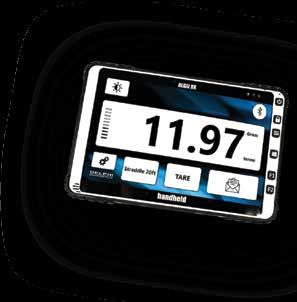
25 minute read
INDUSTRY POLITICS
WiFi and GPS are so entwined in our lives. They have transformed the daily commute, our daily interactions and how businesses do business.
In 2020, they have helped families learn, live and work from home, getting food and supplies delivered to their doorsteps.
Advertisement
They have helped businesses go online and take their business direct to customers.
These two now seemingly indispensable technologies were born by science and the one simple question that drives all innovation: “what if”?
Science and technology have tremendous power to change our lives and to revolutionise industry.
And with the seismic impacts of COVID-19 restrictions and their legacies, affecting supply chains, and fundamentally changing business conditions, it is now more important than ever for industry, and particularly our manufacturers, to wonder “what if”?
What if we were to change our materials?
What if we were to switch up that process?
What if we were to collaborate with someone new?
As we look to chart our economic recovery now and for future generations, it is crucial we get science and technology working for industry – a key pillar of the Morrison government’s $1.5 billion Modern Manufacturing Strategy.
The clever use of both science and technology can be a game changer for our manufacturers. It can improve productivity, make them more competitive and it can create new jobs.
Take, for example, NSW optical company Dresden. It worked in a market where glasses were costly, fragile and made from non-ecofriendly materials.
But they wondered what if they could do something different.
THE HON. KAREN ANDREWS MP – PARLIAMENT OF AUSTRALIA, MINISTER FOR INDUSTRY, SCIENCE AND TECHNOLOGY
THE HON. SENATOR ERIC ABETZ, A MEMBER OF THE POLITICAL ADVISORY BOARD OF CANZUK AND A FORMER LIBERAL MINISTER FOR EMPLOYMENT
USING SCIENCE AND TECHNOLOGY TO GROW AUSTRALIAN MANUFACTURING
Dresden made science and technology work for their vision, finding entirely new partners from the research and university sector alongside other manufacturers.
By pushing the envelope of the possible and utilising research, Dresden now manufactures glasses that are 100 per cent recyclable – transforming milk bottle tops, beer keg taps and discarded fishing nets among other items.
But that’s not the end of the story.
By pursing the philosophy of “what if” it has also changed the market, outpacing China on the manufacture of prescription glasses frames, producing them at a cheaper price than anywhere in the world.
We know there is much more that must be done to see more manufacturers realise their potential.
That is why our Modern Manufacturing Strategy, with the $1.3 billion Modern Manufacturing Initiative at its heart, is designed to supercharge our manufacturing businesses to lead us out of this pandemic
We want to encourage our businesses to seize the opportunities to scale up, become more resilient and more competitive.
We want to back our businesses to leverage their bright ideas and to collaborate with our world-class researchers and scientists.
We want to encourage our businesses to invest in innovation – because by improving their processes and practices to be cuttingedge they can reinvent their products and take on the world – just like Dresden.
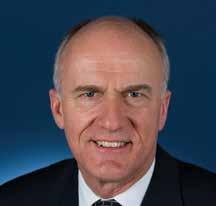
It is frequently (yet incorrectly) stated that the Chinese word for crisis is composed of two Chinese characters signifying "danger" and "opportunity".
Recently, Chinese state media announced a halt on exports from Australia worth more than $6 billion a year that included wine, lobster, copper, sugar, timber and coal that arrived in China after November 6 2020. This announcement came after China placed tariffs on Australian barley and meat earlier in the year.
Months before that, a virus spread from Wuhan across the globe and continues to devastate economies as they deal with its health implications.
A few years before that, the UK decided to unshackle itself from the European Union and forge a new economic destiny.
With these events, Australia is presented with the dangers of uncertainty but also with an opportunity to lay the foundations for Australia's manufacturing future. This once-thriving industry is still capable of producing quality goods for export and domestic markets. The events of 2020 can therefore be the catalyst for an overdue discussion on the future of Australia's manufacturing and how to reorganise it effectively as we face such severe challenges.
CANZUK, CHINA, COVID-19 AND OUR MANUFACTURING FUTURE
Some view Australian manufacturing as a product of a bygone era, obsolete in the age of globalisation, ever-dwindling comparative advantages and a flood of cheap imported goods. Yet manufacturing employs some 860,000 Australian, and before COVID-19 it generated more than $100 billion in annual value to the Australian economy and over $50 billion in exports.
It is more important than ever to keep producing goods in Australia. Manufacturing contributes around one-quarter of total research and development investment in Australia, roughly four times its share of the economy. It is particularly important to regional economies, and in my home state of Tasmania, 1,465 manufacturing businesses employ almost 15,000 people. Last month the federal government announced a new era for Australian manufacturing with the $1.5 billion Modern Manufacturing Strategy to help rebuild the economy and recover from the COVID19-induced recession.
The strategy will make Australian manufacturers more competitive, resilient and able to scale-up to take on the world while building upon our nation's self-sufficiency. It is an opportunity to grow into new and emerging local and global markets.
With increasing global economic uncertainty, there lies the opportunity for Australia to increase its economic cooperation with nations it shares close cultural and historical ties, particularly Canada, New Zealand and the UK.
In 2019-20, trade between CANZUK nations included:
• manufacturing exports to Canada totalling $512.6 million; comprising over 90 per cent of exports to New Zealand with more than 51 per cent engineering products at $3,690.4 million; and
• exports to the UK that were elaborately transformed manufactures and comprised more than 67 per cent of exports, with 46 per cent engineering products at $867.4 million.
According to the DHL Export Barometer 2019 report, growth in export orders from New Zealand topped the list. Growth in export orders from the UK has steadied since 2016, reaching 35 per cent in 2019. The report goes onto highlight the potential of the CANZUK nations, stating:
For it is embracing science and technology and asking “what if” that will have people exclaiming in wonder, “how many?!” How many manufacturing jobs have you created?
This year's results show a more significant number of small to medium-sized businesses entering the export market. For companies new to exporting, we typically see a trend where they concentrate their expansion in markets with familiar consumer buying preferences, cultures and languages. For Australian export businesses, these markets are likely to be other Western nations, such as New Zealand, the US or Canada.
For Australia, there is a high level of uncertainty about the likely impacts of Brexit – with agreements still to be reached between the UK and the EU. Negotiations are continuing with an Australia – United Kingdom Free Trade Agreement and an Australia-European Union Free Trade Agreement.
As Australia – and the world – faces a profoundly uncertain economic future, the nation's manufacturing sector can, with careful nurturing, overcome the problems of the past to be a solution for the COVID-19 economic recovery.
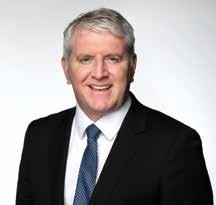
It has been 30 years since Australia last faced the daunting prospects of a recession. Many reading this now probably would not have experienced such a situation as an adult employed, or running a business.
It will take years to recover, but there is no doubt about the important role manufacturing will play in the future of our country as we navigate our way out of the recession our country is facing.
Australian manufacturers were pivotal in the midst of the pandemic as they quickly adapted operations to provide crucial Personal Protective Equipment.
The production of hand sanitiser and face masks helped manufacturers through the pandemic, but COVID-19 exposed the vulnerability of our commodity-based economy to global shocks. In doing that, it revived the importance of a strong Australian manufacturing sector with products made here in Australia.
That is why Labor has launched a plan for a Future Made In Australia – a plan to boost Australian jobs and Australian made products that will benefit our Australian economy. The initial part of this plan was outlined in the Budget-in-Reply speech by Leader of the Opposition Anthony Albanese, in which he outlined our national Rail Manufacturing Plan.
Liberal governments have consistently said we cannot build trains here, yet the ones they have bought from overseas have been too long for our stations, too narrow for our tracks, or too tall for our tunnels. Our country has the skills and the knowhow. By manufacturing trains here, Labor’s plan would create up to 659 full-time jobs, as well as a rolling stock export industry and boost Australia’s GDP by up to $5 billion.
Manufacturing is critical to Australia’s economic future, to the prosperity of our regions and to the capabilities that underpin the success of so many other industries.
Federal Labor welcomes the government’s new focus on manufacturing, however we remain concerned about what we perceive as a lack of ambition. While the Morrison government has announced $1.5 billion of funding, less than 3 per cent of that money – only $40 million – will be available to manufacturers this financial year.
The Coalition government continuously talks about the importance of medical technology and manufacturing as we deal with COVID-19 and the recession, which begs the question, why won’t this government provide greater support to Australian companies at the time they need it most?
A lack of immediate action will jeopardise Australian jobs and will mean the recession will be deeper and longer than it need be.
As we look to the future and how we best emerge from the health crisis and recession, we have to focus on how to establish well paid, skilled and secure jobs.
Active Australian industry policy will see jobs in Australia, will prevent Australian talent leaving our shores for opportunities overseas, and grow our economy. Industry policy should foster greater collaboration between industry, small and medium enterprises, and government bodies like the CSIRO; a comprehensive public procurement policy; and encouraging start-ups to scale up.
I am optimistic about the future of manufacturing in this country. We have shown in the past that we are an innovation nation and we can continue to be.
In Bruce Springsteen’s 1978 ode to factory workers he said “men walk through these gates with death in their eyes”, but the factories and workshops of the future will be vastly different to that. Manufacturing workers – men and women – will go to work safe in the knowledge that in this country a career in manufacturing can be prosperous and lifelong.
THE HON: BRENDAN O'CONNOR - MP PARLIAMENT OF AUSTRALIA, SHADOW MINISTER FOR EMPLOYMENT AND INDUSTRY
LABOR PLAN TO BOOST AUSTRALIAN JOBS AND PRODUCTS
HELP IN WORKING THROUGH THE WORKPLACE REGULATORY MAZE
Many employers and business owners have to deal with an array of regulative guidelines to which their workplaces need to adhere to operate sustainably and productively.
The area of safety and occupational health, in particular, can be a minefield.
This is where the Occupational Health and Safety Consulting (OHS) and Software company Safety for Life can help. Based in Brisbane, it is active face-to-face and online, providing skills in OHS, Er-gonomics, Risk Management, Auditing, Injury, and Business Management.
Director/Principal Consultant Caroline Kingston says the group always keeps up-to-date with legislative changes to ensure ciients receive the latest relevant information for businesses to operate safely and riskfree.
“We have 10 years of experience, knowledge and real-life application behind us, with as varied sec-tors such as professional services, health, mining and quarrying, manufacturing, government, transport and warehousing,” Ms Kingston said.
Safety for Life uses SHERM software systems (Safety, Health, Employees, Risk Management), designed by Ms Kingston. SHERM was built with the intent of streamlining business efficiencies for administration and management of compliance, risk management, training as well as auditing.
“SHERM can easily be configured and its simple functionality makes it easy for all staff to apply re-porting, documentation, notification, tracking and alerting process, daily in their working lives,” Ms Kingston said.
Safety for Life also has kept up with the times making sure that SHERM software is scalable for any new client needs and can be set up as a mobile phone app.
Ms Kingston also says that SHERM covers management systems for, safety, quality, and environ-mental management, including what is applicable during the post-COVID-19 business environment.
SHERM software is hosted in the cloud with leading technology in the application design, and users have access 24/7. It is a web-based application that operates on Internet Explorer, Chrome, Fire-fox, Mozilla, Safari browsers
“Clients’ feedback had been really valuable for me in terms of building a software application that can meet a broad range of specific requirements across the range of sectors that I’m dealing with,” Ms Kingston says.
She said Safety for Life could help businesses obtain certification to increase their competitive edge and meet necessary Australian standards.

Safety for Life's Caroline Kingston
Safety For Life www.safetyforlife.com.au
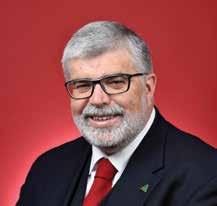
In any kind of business, the effectiveness of the organisation depends in large part on the quality of its leadership.
That is true at any time, but especially now when global trade relations have been disrupted by the pandemic and increasing tension between the United States and China.
It is therefore profoundly disturbing that the Morrison government has decided to replace the Anti-Dumping Commissioner, Mr Dale Seymour, and the CEO of the Australian Nuclear Science and Technology Organisation (ANSTO), Dr Adi Paterson.
All manufacturers know that the work of the Anti-Dumping Commission is vital in preventing unfair competition from cheap – and often substandard – foreign imports.
And, ANSTO is an important manufacturer in its own right, as a producer of the radiopharmaceuticals that are increasingly widely used in diagnostic and treatment procedures.
ANSTO estimates that two in three Australians receive one of its products at some point in their lives, and the organisation has a thriving export business because of the quality of those THE HON. SENATOR KIM CARR, FORMER MINISTER AND SHADOW MINISTER FOR INNOVATION, INDUSTRY, SCIENCE AND RESEARCH
QUESTIONS REMAIN OVER DEPARTURE OF TWO SENIOR PS HEADS
products. ANSTO has been prominent in building Australia’s profile as an advanced manufacturing nation.
So why are Mr Seymour and Dr Paterson no longer required at their posts? I sought answers to that question at the most recent Senate estimates hearings, but neither the government, nor officers of the Department of Industry, Science, Energy and Resources, nor Dr Paterson’s interim successor at ANSTO were inclined to provide them.
What is clear, however, is that in neither case did the decision have anything to do with allegations of incompetence or inefficiency.
Both men are highly regarded public servants with deep knowledge of the fields in which they work. There has not been even a hint of mismanagement, and the quality of their leadership is acknowledged by all who have come into contact with them.
In Dr Paterson’s case, the government has taken refuge in the fact that he was not officially dismissed but resigned. It is, however, a curious kind of resignation. His tenure as CEO would have run until March 2022, so to describe his departure in the language of ANSTO’s official announcement as “slightly ahead of time”, is, to put it mildly, a breathtaking understatement.
This so-called resignation has been contested. We will know how bitter the contest has been when the lawyers send their final bills, even if the terms of settlement are confidential.
We do not know what conversations the government might have held with Dr Paterson before he submitted his resignation, but we do know that the Department of Finance is conducting a study of ANSTO’s “governance and financial arrangements”.
The inquiry is considering possible privatisation of ANSTO, and it is difficult to avoid the likelihood that Dr Paterson was placed in a position in which he felt he had no option but to resign.
Mr Seymour continues in his job for the present, but the position of Anti-Dumping Commissioner was advertised in August this year.
He told the estimates hearing that he had had a brief conversation with the Industry Minister about her plans and had not reapplied for his job. Nor is he involved in the process of choosing his successor.
Mr Seymour did not say that he was told he is no longer required, but that is clearly what has happened.
Readers of Industry Update will know that the effectiveness of Australia’s antidumping regime depends heavily on the capabilities of the Commissioner.
The person who fulfills that role has to understand the complexities of domestic and international law affecting trade, to be able to assess fairly claims of dumping or unfair subsidisation of foreign imports, and to make appropriate adjudications.
A likely consequence of the pandemic is that there will be increased dumping as markets reopen around the world. Why, at such a time, would the government decide to dispense with someone of Mr Seymour’s undoubted experience and abilities?
Mr Seymour is Australia’s first AntiDumping Commissioner, appointed in 2013 and reappointed in 2018. The fact that he has been denied even the opportunity of seeking another term suggests that the government is pursuing a partisan agenda, rather than one based on Australia’s needs.
Like Dr Paterson, Mr Seymour happens to have been first appointed under a Labor government. Neither man could be accused of having ever acted in a partisan manner in the conduct of their office, but it may be that they have been identified as partisan targets nonetheless.
If so, the nation stands to lose two excellent public servants for no fault of their own.
These are uncertain and even dangerous times, and the lack of judgment the government has demonstrated in this matter will do nothing to increase certainty and stability – for business, for industry, and for the people of Australia.
BID TO INCREASE FEMALE PARTICIPATION IN STEM JOBS
The federal government has launched a new initiative to inspire girls to see their future in a range of jobs using science, technology, engineering and mathematics (STEM) skills.
Minister for Industry, Science and Technology Karen Andrews said the Future You initiative would help raise awareness of the exciting career possibilities in STEM for the next generation.
“We know that a lack of role models and understanding of STEM careers reduces girls’ interest and confidence in STEM subjects as early as Year 4 – but we want to change that,” Ms Andrews said. participation in STEM subjects and opening their eyes to a career which uses these skills.
“Empowering girls to see a future for themselves in a STEM career is a crucial part of our efforts to ensure everyone has the opportunity to benefit from the jobs of the future, which is not only good for the girls and women themselves, but also for our economy.”
The Future You initiative is led by the federal government’s Women in STEM Ambassador Professor Lisa Harvey-Smith.
“STEM subjects are not just for scientists and engineers – they are for everyone. Future You shows young people just how exciting, vibrant and rewarding a STEM skilled career can be,” Professor Harvey-Smith said.
The Future You online platform is aimed at children aged 8 to 12, as well as their parents and carers, and features 12 diverse and relatable characters, including a builder, miner, game designer, farmer, nurse, ecologist and a Moon to Mars Mission Director.
The campaign includes a website with video animations, skill-based games and information about STEM and can be found here www.womeninstem.org.au/futureyou.
Future You is funded through the $1.5 million Women in STEM National Awareness Raising Initiative, as part of the Australian Government’s Advancing Women in STEM strategy.
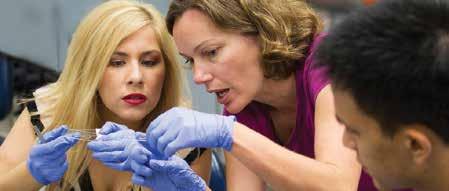
SWISSLOG AUTOMATION TECHNOLOGY WINS MAJOR INTERNATIONAL AWARD
A fully automated mixed case palletising solution developed by Swisslog has been recognised for delivering new levels of efficiency.
The company’s ACPaQ system has won the prestigious German Logistics Award 2020 for its use at retail chain dmdrogerie markt.
The same technology was first installed at Coca-Cola Amatil’s New Zealand distribution centre in Auckland and is widely applicable to logistics, distribution, food and beverage and retail applications in Australasia.
Coca-Cola Amatil New Zealand has collaborated with Swisslog on automated storage and receival systems for more than 10 years, and sought to make further improvements to its customer service and costs, to meet rising demand.
“Swisslog’s ACPaQ automation solution replaces a manual, voice-directed picking system, and will link with the existing automated pallet store to create a seamless operation,” said Mr Sean Ryan, Head of Sales and Consulting, Swisslog Australia.
The ACPaQ technology is an evolution of the company’s advanced automation technology, which combines robotics solutions for palletising and depalletising with Swisslog’s CycloneCarrier shuttle technology to create a fully automated process that facilitates high throughput and reliable picking of orders.
Using the Load Build Manager functionality from Swisslog’s ‘SynQ’ software, the robots perform palletising in a sequential packing order – individually adapted to the depalletising or shelf-filling routes in each dm store, according to the last-in-first-out principle.
At dm-drogerie markt, its innovative new distribution centre is part of the group’s investment in automation and robotics with a focus on sustainability and competitiveness.
“As dm’s automation partner for intralogistics at Wustermark, a lot of passion and innovation has gone into this project,” said Swisslog CEO, Dr Christian Baur.
“We are very pleased that dmdrogerie markt has won this prestigious award. On behalf of the entire Swisslog team, I would like to sincerely congratulate dm,” he added.
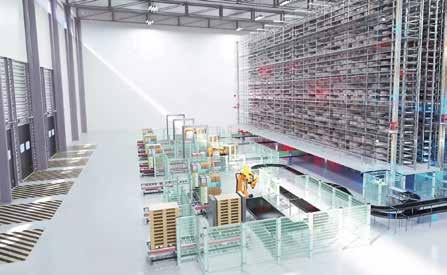
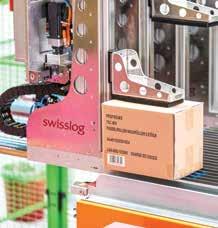
“We have worked closely together on the robotics and material flow over the last few years so I am therefore all the more pleased that the distribution centre has been presented with this accolade.”
Swisslog Australia Pty Ltd 02 9869 5900 www.swisslog.com
TURNING AN ORDINARY BOX, JAR OR BOTTLE INTO A TAMPER EVIDENT CONTAINER

Due to the changes in local regulations, Australian scientists running quality control programs rapidly needed ways to ensure that all jars containing toxic waste and being collected for destruction were both security sealed and had not been subject to tampering.
Instead of replacing the jars, simply adding a tamper evident label over the jar head, not only met the required level of security, it also had plenty of room to add signatures. New procedures required that the person sealing the jar had to sign the label.
This is just one example that illustrates how easy it is to add tamper evidence to a container. The label used to seal the jar was a HR residue security label from Harcor.
It is ideal for multiple applications for most non-porous surfaces. The size and design of the container to be sealed will determine the quantity of labels needed.
Security labels are available in a variety of styles. Self-destruct labels work by breaking into fragments when removed to stop them from being replaced after application.
The HR residue label shows a “void/ open” message on the label face and container surface when removed. If a container is not going to be reused again, a HR residue security label could be ideal for the application.
The HNR non-residue security label does not leave a film behind on the surface; it does however show a void/open message on the label face when removed. This is perfect for use on containers that are going to be regularly reused.
Unique serial numbering is a security feature that enables traceability. Harcor is known for the proprietary track and trace technology used to manage serial numbering. This is used to prevent number duplication and enable fast tracking.
Harcor’s in-house specialists can assist with security label selection.
Strategically located throughout Australia – with branches in Sydney, Melbourne and Brisbane – Harcor works in partnership with clients to provide tailored solutions supported by the best possible service.
Harcor Master Security Licence No. 407319937 Web: harcor.com.au Email: sales@harcor.com.au
PILBARA ENERGY HUB GIVEN MAJOR STATUS BACKING
$240M SOUTH AUSTRALIA HYDROGEN PROJECT TO BE WORLD LEADER
The Morrison government is helping fast-track the world’s largest green hydrogen and ammonia production facility, which is expected to create tens of thousands of jobs in Western Australia.
The proposed Asian Renewable Energy Hub (AREH) in the Pilbara region is expected to support more than 20,000 direct and indirect jobs during construction over 10 years, and 3000 jobs when fully operating.
In granting it Major Project Status, Minister for Industry, Science and Technology Karen Andrews said the facility will include the world’s largest wind and solar electricity plant.
“The Asian Renewable Energy Hub has the potential to transform the East Pilbara and neighbouring Broome shire and to contribute to a major new export industry for Australia,” Ms Andrews said.
“Not only will the plant be able to export at scale, it will also be able to supply industries in the region while creating new job opportunities and economic growth.”
Minister for Energy and Emissions Reduction Angus Taylor said the project would build on Australia’s strengths as a major energy exporter while helping to reduce global emissions.
“This project has the potential to help lower global emissions while building a new Australian industry that creates jobs and opportunities in regional Australia,” Mr Taylor said.
“Projects like the Asian Renewable Energy Hub will help us achieve our ‘H2 under $2’ goal and position Australia as a world leader in clean hydrogen.”
The 'H2 for under $2' target is a goal set by the government to produce hydrogen fuel for under $2 per kilogram.
Mr Taylor said the Government’s Technology Investment Roadmap highlights hydrogen as one of the priority technologies to deliver a cleaner future for Australia.
Australia’s emerging hydrogen industry has the potential to generate 7600 new jobs by 2050, with exports estimated to be worth around $11 billion a year in additional GDP. The government has committed more than $570 million to back the development of an Australian hydrogen industry.
AREH Project Director Brendan Hammond said securing Major Project
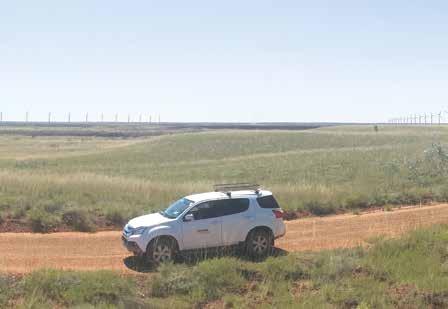
Part of the hub site in the Pilbara
Status represented a significant project milestone.
“It sends a strong signal to everyone involved, including potential customers and investors, that our project is at the forefront of an emerging green hydrogen industry for Australia, and the opening of a massive new export market to the fastgrowing Asian economies to our north,” Mr Hammond said.
Major Project Status is the Commonwealth government’s recognition of the strategic significance of a project to Australia. It provides companies with extra support from the Major Projects Facilitation Agency, including a single entry point for Commonwealth Government approvals, project support, and coordination with state and territory approvals.
South Australia’s intention to create a green hydrogen export industry has taken a big step forward, this month with the launch of a world-leading $240 million hydrogen project.
This project would be the largest green ammonia plant in the world, being 60 times larger than Australia’s largest electrolyser at Tonsley in Adelaide.
The initial stage of the H2U Eyre Peninsula Gateway Hydrogen Project will see the installation of a 75MW electrolyser near Whyalla, capable of producing enough hydrogen to create 40,000 tonnes of ammonia each year. It is targeted for completion in late 2022.
The project will be later expanded to the export stage, which will provide an industrial-scale facility with a total production capacity of up to 2,400 tonnes per day of green ammonia, designed to drive further exports.
Demand is strong. Japan already has identified green ammonia as a key fuel to reduce its carbon emissions and fuel its economy.
Because of the export potential , the SA government is allocating $37 million in the upcoming 2020-21 State Budget to upgrade the Port Bonython jetty.
Premier Steven Marshall said upgrading the jetty would unlock significant investment and export opportunities for South Australia, with hydrogen driving renewed interest in Port Bonython.
“South Australia’s ambition to create, use and export green hydrogen is getting global attention, and has great potential to create jobs and sustain long-term investment,” Mr Marshall said.
“Maintaining this critical piece of infrastructure will unlock further export opportunities in key markets, particularly across Asia, boosting economic activity and creating jobs in our state. working to assist Australian company H2U to establish connections with potential international customers, and its hydrogen project at Pt Bonython is a very exciting one for South Australia.”
Mr Marshall said the $240 million demonstrator phase of the project was of global significance, but was just the precursor to a much larger production and export facility that could also strengthen the state’s energy ties with traditional trading partners.
“This comes at the perfect time, as we lead our economic recovery from the global coronavirus pandemic,” he said.
SA Energy and Mining Minister Dan van Holst Pellekaan congratulated H2U on the project and committed to helping fast-track the project’s development.
“Our intention of net-100 per cent renewable energy generation by 2030 will produce some of the most cost-effective green hydrogen in the world,” he said.

SA Premier Steven Marshall
Chief Executive Officer of H2U, Dr Attilio Pigneri said the project would help drive the development of the emerging markets for green hydrogen and green ammonia.
“It offers the opportunity to export South Australia’s abundant solar and wind resources to support deep decarbonisation in the global energy, industrial and shipping sectors,” he said.
“In the energy sector, Japan is leading the way with its plan to introduce green ammonia as a substitute fuel, to help meet its decarbonisation targets.”



